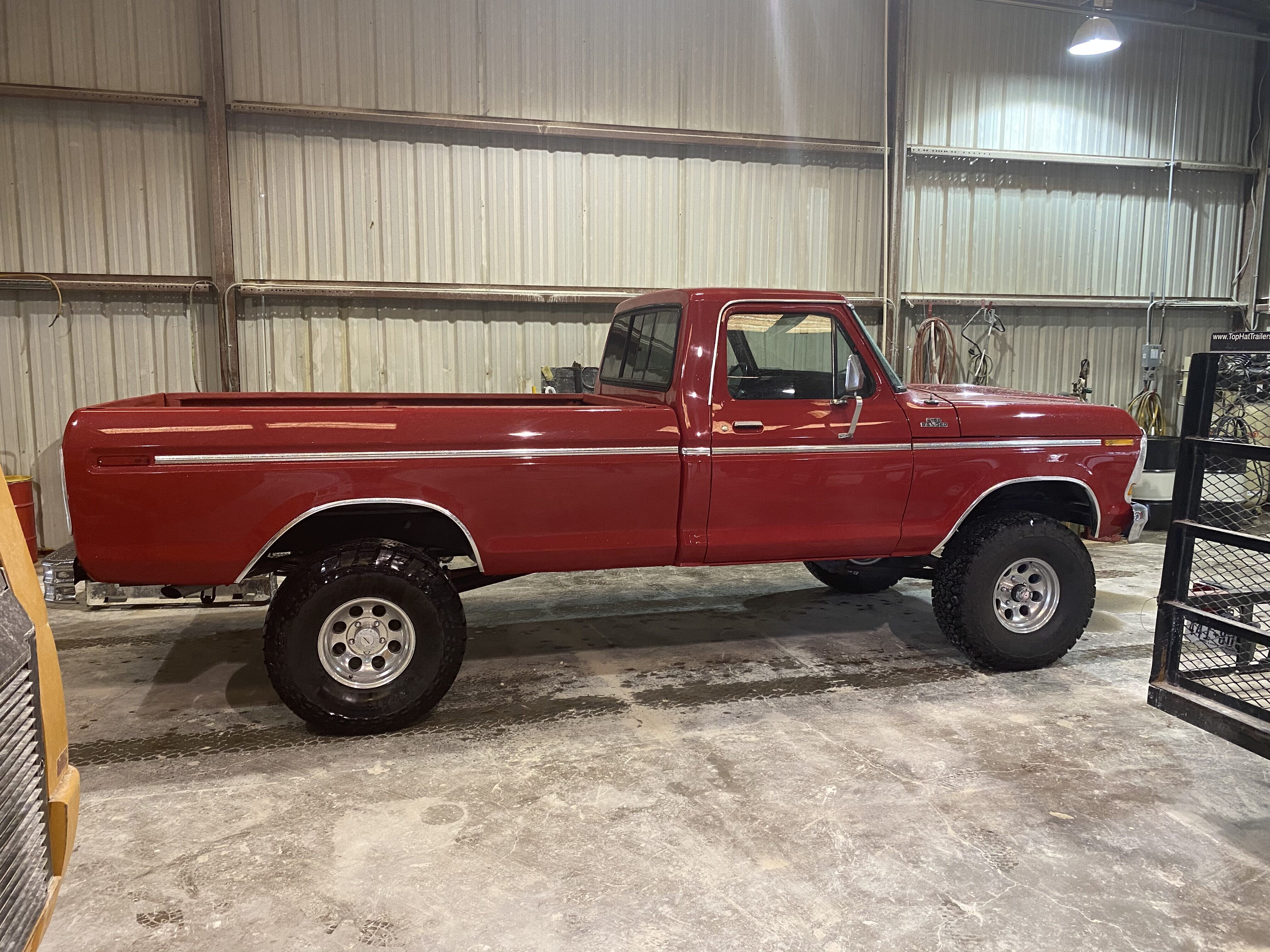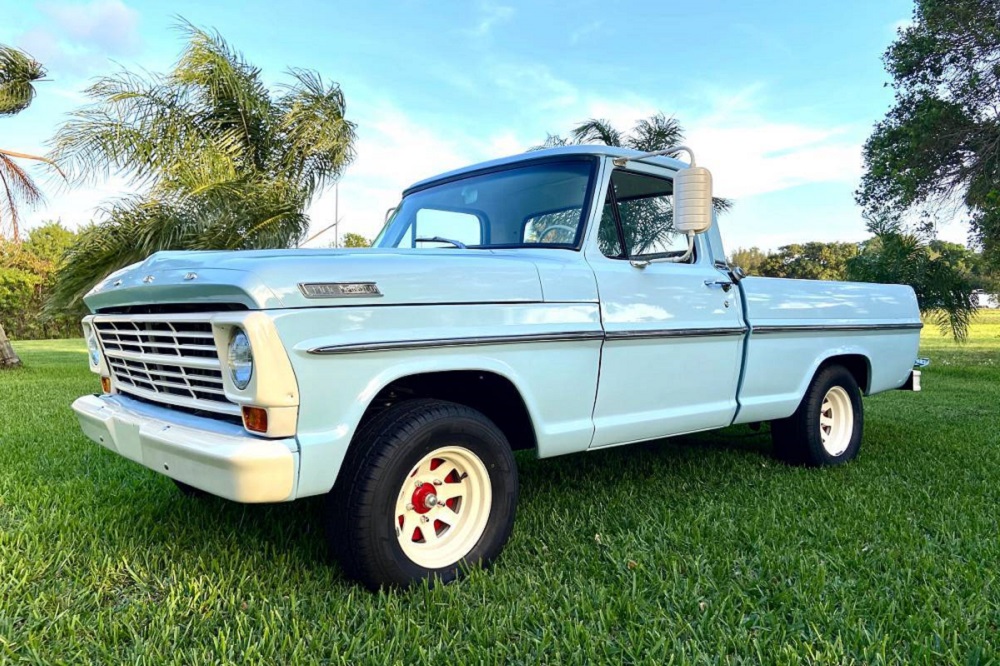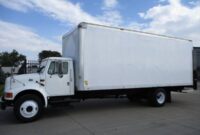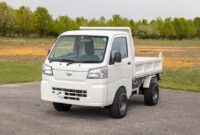Classic Ford 4×4 Trucks For Sale: A Comprehensive Buyer’s Guide pickup.truckstrend.com
In the vast landscape of automotive enthusiasts, few vehicles stir the soul quite like a classic Ford 4×4 truck. These aren’t just old vehicles; they are rolling testaments to American ruggedness, utility, and enduring design. From the iconic roar of their V8 engines to the unmistakable lines that defined generations, classic Ford 4x4s embody a unique blend of nostalgia, raw capability, and timeless appeal. For many, owning one is a dream—a chance to connect with automotive history, embark on off-road adventures, or simply cruise in a vehicle that truly stands out.
This comprehensive guide is designed for anyone considering diving into the world of classic Ford 4×4 trucks. We’ll explore what makes them so special, where to find them, what to look for, and how to navigate the exciting, yet sometimes challenging, journey of bringing one home. Whether you’re a seasoned collector, a budding restorer, or simply seeking a unique and capable ride, understanding the nuances of these magnificent machines is the first step toward a rewarding ownership experience.
Classic Ford 4×4 Trucks For Sale: A Comprehensive Buyer’s Guide
The Enduring Appeal of Classic Ford 4x4s
Why do these vintage workhorses continue to captivate buyers decades after their production? The reasons are as varied as the trucks themselves:
- Timeless Design & Nostalgia: Ford’s classic truck designs, particularly from the 1960s, 70s, and early 80s, possess an unmistakable aesthetic. Their robust, no-nonsense lines evoke a sense of a bygone era, sparking fond memories for many and a desire for authenticity in a modern world.
- Built to Last (and Easy to Fix): These trucks were engineered for durability. While age brings wear, their mechanical simplicity often means they are easier and more affordable to repair than modern, computer-laden vehicles. Many parts are still readily available, and a passionate community provides a wealth of knowledge.
- Unmatched Customization Potential: The aftermarket for classic Ford trucks is enormous. From mild lifts and tire upgrades to full engine swaps, modern suspension systems, and custom interiors, these trucks serve as a blank canvas for personalization, allowing owners to create a vehicle perfectly suited to their needs and style.
- Off-Road Prowess & Utility: Ford’s 4×4 systems from this era were robust and effective. Whether it’s tackling challenging trails, hauling a trailer, or simply navigating rough terrain, these trucks were designed for serious work and play.
- Investment Potential: While not all classic trucks appreciate equally, certain models and well-preserved or expertly restored examples, especially early Broncos and clean F-Series trucks, have shown significant value appreciation, making them potentially sound investments in addition to being cherished possessions.
- Community and Heritage: Owning a classic Ford 4×4 connects you to a vibrant community of enthusiasts. Car shows, online forums, and local clubs provide opportunities to share knowledge, find parts, and celebrate the shared passion for these automotive legends.

Iconic Models and What Makes Them Desirable

Ford produced a diverse range of 4×4 trucks over the decades, each with its own unique character and appeal.
- Ford Bronco (1st Generation, 1966-1977): Often considered the "holy grail" of classic Ford 4x4s, the early Bronco is a compact, highly versatile SUV. Its short wheelbase, rugged Dana axles, and distinctive styling make it incredibly popular for off-roading, restoration, and as a collector’s item. Prices for these have soared in recent years, particularly for well-restored or resto-modded examples.
- Ford F-Series (Bumpside, 1967-1972): Named for the characteristic "bump" along the side trim, these F-100, F-150, and F-250 trucks are celebrated for their clean lines and robust build. They offer a great blend of classic looks and practical utility, with a wide range of engine options, including the popular FE series big blocks.
- Ford F-Series (Dentside, 1973-1979): The "Dentside" F-Series represents the peak of Ford’s classic truck production, offering a more refined ride than its predecessors while maintaining the ruggedness. These trucks are plentiful, making parts and donor vehicles easier to find. The F-150 became a prominent model during this era, and the 4×4 variants are highly sought after for their capability and classic appeal.
- Ford F-Series (OBS – Old Body Style, 1992-1997): While newer than what some consider "classic," the OBS F-Series has garnered immense popularity, especially the F-250 and F-350 models equipped with the legendary 7.3L Power Stroke diesel engine. Their robust nature, iconic styling, and strong aftermarket support have cemented their status as modern classics, offering a blend of vintage feel with more modern amenities.
- Ford Ranger (Early Generations, e.g., 1983-1992): For those seeking a more compact and potentially more budget-friendly classic 4×4, early Ford Rangers are emerging as desirable options. They offer genuine 4×4 capability in a smaller package, ideal for light off-roading or as a distinctive daily driver.

Where to Begin Your Search for a Classic Ford 4×4
Finding your ideal classic Ford 4×4 can be an adventure in itself. Here are the most common avenues:
- Online Marketplaces:
- Specialized Auction Sites: BringATrailer.com, eBay Motors, Hemmings.com, ClassicCars.com often feature high-quality, well-documented vehicles.
- General Classifieds: Facebook Marketplace, Craigslist (use caution and local pickup only).
- Classic Truck Forums & Clubs: Many enthusiast communities have "for sale" sections where you can find direct sales from owners.
- Specialized Dealerships & Restorers: Several businesses focus exclusively on buying, restoring, and selling classic Ford trucks, particularly Broncos. They often offer high-quality, turn-key vehicles, but at a premium price.
- Auctions: Major automotive auctions (e.g., Barrett-Jackson, Mecum Auctions) regularly feature classic trucks, though prices can be highly competitive. Local auctions might yield hidden gems, but often without much pre-sale information.
- Private Sellers: Word-of-mouth, local classifieds, or even spotting a "for sale" sign on a parked truck can lead to direct sales. This often offers more negotiation room.
- Car Shows & Swap Meets: Attending these events can not only help you see various models in person but also connect you with owners who might be looking to sell.
The Crucial Pre-Purchase Inspection (PPI)
Before you commit to buying a classic Ford 4×4, a thorough inspection is paramount. Many of these vehicles are decades old, and potential issues can be hidden.
- Rust is the Enemy: This is arguably the biggest concern. Check:
- Frame: Look for cracks, repairs, or heavy pitting.
- Body Panels: Pay close attention to cab corners, rocker panels, fender wells, floorboards, and the bed floor. Check under any bed liners.
- Mounting Points: Inspect where the body meets the frame, and suspension components attach.
- Engine & Drivetrain:
- Engine: Look for oil leaks, listen for strange noises (knocks, ticks, excessive lifter noise), check exhaust smoke (blue for oil, white for coolant, black for rich fuel).
- Transmission: Check fluid levels and condition. Test all gears, including reverse. Listen for grinding or slippage.
- 4×4 System: Engage 4-high and 4-low. Ensure the transfer case shifts smoothly and the front axle engages. Listen for unusual noises during engagement and while driving in 4WD.
- Axles: Check for leaks around differentials and axle seals.
- Suspension & Steering:
- Look for worn bushings, ball joints, tie rods, and shock absorbers.
- Check for excessive play in the steering wheel.
- Listen for clunks or squeaks over bumps.
- Brakes:
- Test pedal feel (should be firm, not spongy).
- Check for fluid leaks around calipers/wheel cylinders.
- Ensure the truck stops straight without pulling.
- Electrical System:
- Test all lights (headlights, taillights, turn signals, brake lights), gauges, wipers, heater/AC.
- Look for frayed or spliced wiring, which can indicate past issues.
- Interior:
- Assess the condition of seats, dashboard, headliner, and door panels. These can be expensive to restore.
- Check for water leaks or mold, especially if the truck has sat outside.
- Paperwork:
- Verify a clear title.
- Ensure the VIN on the title matches the VIN on the truck (usually on the door jamb and frame).
- Check for any lienholders or discrepancies.
- Professional Pre-Purchase Inspection (PPI): If you’re not mechanically inclined or buying from a distance, invest in a PPI from a trusted mechanic specializing in classic vehicles. This small investment can save you thousands down the road.
Understanding Condition, Valuation, and Budgeting
The price of a classic Ford 4×4 varies dramatically based on its condition, rarity, and the quality of any restoration work.
- Condition Tiers:
- Project (Lowest Price): Needs significant mechanical, body, and/or interior work. Best for experienced restorers or those with deep pockets for professional work.
- Driver Quality: Runs and drives reliably, but may have cosmetic flaws, minor mechanical issues, or a tired interior. Usable as-is, but not show quality. A great starting point for those wanting to improve over time.
- Survivor: An original, unrestored vehicle that has been exceptionally well-preserved. These are rare and command high prices due to their originality.
- Restored: Professionally rebuilt to original or near-original specifications. High-quality paint, fresh mechanicals, and a clean interior. These command premium prices.
- Resto-Mod (Highest Price): Combines classic aesthetics with modern performance and comfort (e.g., modern engine swaps, upgraded suspension, AC, power steering/brakes). These are built for daily driving and command the highest prices.
- Factors Influencing Price:
- Model & Year: Early Broncos are generally the most expensive.
- Engine & Transmission: Desirable engines (e.g., 302, 351, 460, 7.3L Power Stroke) and manual transmissions can increase value.
- 4×4 Status: 4×4 variants are almost always more valuable than 2WD.
- Originality vs. Modifications: For some, originality is key; for others, tasteful modifications are desirable.
- Documentation: Service records, original build sheets, or previous ownership history can add value.
- Geographical Location: Prices can vary regionally.
Budgeting Beyond the Purchase Price: Don’t forget to factor in:
- Insurance: Look for specialized classic car insurance.
- Registration & Taxes: Standard vehicle fees apply.
- Maintenance & Repairs: Even a "ready-to-drive" classic will need ongoing attention.
- Upgrades: You’ll likely want to personalize or improve certain aspects.
- Fuel: Older trucks, especially with larger engines, can be thirsty.
Restoration vs. Ready-to-Drive: Your Path to Ownership
Deciding whether to buy a project or a completed truck depends on your skills, budget, and patience.
- Buying a "Project" Vehicle:
- Pros: Lower initial cost, full control over the restoration process, learning experience, deep satisfaction from completion.
- Cons: Can be a money pit (often costing more than buying a finished truck), requires significant time, mechanical skill, and dedicated space. Can lead to frustration if unprepared.
- Buying a "Ready-to-Drive" (Driver/Restored/Resto-Mod):
- Pros: Immediate enjoyment, less personal effort, potentially higher reliability from the start.
- Cons: Higher initial purchase price, you’re relying on the quality of someone else’s work, less control over specific components unless it’s a custom build.
Actionable Advice: Be honest with yourself about your capabilities and resources. A "driver" quality truck often offers the best balance for new owners—you can enjoy it immediately while slowly addressing improvements.
Common Challenges and Smart Solutions
Owning a classic Ford 4×4 comes with its unique set of challenges, but most have well-established solutions.
- Parts Availability: For popular models like the F-Series and early Broncos, aftermarket support is excellent. Companies like LMC Truck, Dennis Carpenter, National Parts Depot (NPD), and countless smaller specialists offer reproduction panels, mechanical components, and interior parts. Online forums and junkyards are also valuable resources.
- Finding Qualified Mechanics: Not all modern repair shops are equipped or willing to work on vintage vehicles. Seek out classic car restoration shops, off-road specialists, or experienced independent mechanics who understand older platforms. Building a relationship with such a mechanic is invaluable.
- Rust: The ongoing battle. Addressing rust properly (cutting out and replacing affected metal) is crucial. Surface rust can be managed, but structural rust is a serious safety concern. Prevention (garaging, regular cleaning, undercoating) is key for long-term preservation.
- Modernizing for Daily Use: Older trucks lack modern conveniences. Solutions include:
- Power Steering/Brakes: Common upgrades for easier driving.
- Air Conditioning: Aftermarket kits are available.
- Fuel Injection (EFI Conversion): Replaces carburetors for better cold starts, fuel economy, and reliability.
- Suspension Upgrades: Modern shocks, springs, and steering components improve ride quality and handling.
- Insurance: Standard auto insurance companies may not properly value a classic truck. Seek out specialized classic car insurance providers (e.g., Hagerty, Grundy, American Collectors). They offer "agreed value" policies, which means they’ll pay a pre-determined amount if your vehicle is totaled, reflecting its true market value. These policies often have mileage restrictions and require secure storage.
Estimated Price Guide for Classic Ford 4×4 Trucks
Please note: These prices are highly variable and depend heavily on specific model year, engine, transmission, options, geographic location, market demand, and the overall condition and originality of the vehicle. This table serves as a general guide only.
| Model & Generation | Year Range | Condition (Est.) | Estimated Price Range (USD) | Key Features / Notes |
|---|---|---|---|---|
| Ford Bronco (1st Gen) | 1966-1977 | Project | $15,000 – $40,000 | The highly sought-after original compact SUV. Requires significant work. |
| Driver Quality | $40,000 – $80,000 | Good running condition, may have minor cosmetic flaws or need some TLC. | ||
| Restored/Resto-Mod | $80,000 – $250,000+ | Professionally restored to original spec or modernized with upgraded powertrain/comforts. Top-tier examples can exceed $300K. | ||
| Ford F-Series (Bumpside) | 1967-1972 | Project | $5,000 – $15,000 | F-100, F-250. Classic pick-up lines, robust chassis. |
| Driver Quality | $15,000 – $35,000 | Solid and reliable for regular use, with some cosmetic wear. | ||
| Restored/Clean | $35,000 – $80,000+ | High-quality restoration or exceptionally well-maintained original examples. | ||
| Ford F-Series (Dentside) | 1973-1979 | Project | $4,000 – $12,000 | F-100, F-150, F-250. Popular, good parts availability. |
| Driver Quality | $12,000 – $30,000 | Reliable workhorse, suitable for utility or cruising. | ||
| Restored/Clean | $30,000 – $70,000+ | Excellent condition, often with desirable engine options (e.g., 460 V8). | ||
| Ford F-Series (OBS) | 1992-1997 | Project | $3,000 – $10,000 | F-150, F-250, F-350. Diesel models (7.3L Power Stroke) are highly valued. |
| Driver Quality | $10,000 – $25,000 | Strong, capable, often used as dependable work trucks. | ||
| Clean/Low Miles | $25,000 – $60,000+ | Well-preserved or recently serviced examples, especially those with the 7.3L Power Stroke. | ||
| Ford Ranger (Early Gen) | 1983-1992 | Project | $2,000 – $6,000 | Smaller, more fuel-efficient, emerging as a compact classic. |
| Driver Quality | $6,000 – $15,000 | Reliable compact 4×4, good for light off-roading or as a distinctive daily. | ||
| Clean/Low Miles | $15,000 – $30,000 | Rare, exceptionally well-preserved examples. |
Frequently Asked Questions (FAQ)
Q: Are classic Ford 4x4s reliable for daily driving?
A: They can be, but often require more diligent maintenance and a different driving approach than a modern vehicle. Many owners perform upgrades like electronic fuel injection (EFI) conversions, modern ignition systems, and improved cooling to enhance reliability for daily use. Expect to spend more time on maintenance than with a new car.
Q: How much does it cost to maintain a classic Ford 4×4?
A: This varies widely. Basic maintenance (oil changes, tune-ups) can be affordable due to simple mechanics. However, major repairs or extensive restoration can be very expensive. Budget for ongoing costs, as parts, while available, can add up, and specialized labor can be costly.
Q: Where can I find parts for my classic Ford 4×4?
A: There are numerous dedicated suppliers like LMC Truck, Dennis Carpenter, National Parts Depot (NPD), and countless smaller, specialized vendors. Online forums, eBay, and even local junkyards (for non-reproduction parts) are also valuable resources.
Q: What’s the best classic Ford 4×4 model for off-roading?
A: The 1st Generation Ford Bronco is legendary for its off-road prowess due to its compact size, short wheelbase, and robust drivetrain. Later F-Series trucks (F-150, F-250) also offer excellent capability, especially with lifted suspensions and larger tires.
Q: Is buying a classic Ford 4×4 a good investment?
A: While some models, particularly well-preserved 1st Gen Broncos and clean, original F-Series trucks, have shown appreciation in value, it’s generally best to consider a classic truck a passion purchase first, and an investment second. Factor in the cost of purchase, maintenance, and potential upgrades before expecting a significant return.
Q: How do I get insurance for a classic truck?
A: Standard auto insurance may not provide adequate coverage. Look for specialized classic car insurance companies such as Hagerty, Grundy, or American Collectors. They offer "agreed value" policies, which ensure you’ll receive a pre-determined amount if the vehicle is totaled, reflecting its true market value. These policies often have stipulations like limited annual mileage and secure garaged storage.
Conclusion
Owning a classic Ford 4×4 truck is more than just acquiring a vehicle; it’s embracing a piece of American automotive history, a commitment to a unique driving experience, and an entry into a passionate community. These trucks offer a compelling blend of rugged capability, timeless style, and a connection to a simpler, more mechanically driven era.
The journey of finding, inspecting, purchasing, and maintaining your classic Ford 4×4 can be filled with challenges, but the rewards are immeasurable. From the satisfying thrum of a vintage V8 to the proud glances from passersby, every drive becomes an experience. Whether you seek a project to pour your heart into or a turn-key classic ready for adventure, the world of classic Ford 4×4 trucks awaits, offering a rewarding blend of utility, nostalgia, and pure, unadulterated cool. Embrace the journey, do your homework, and prepare to forge new memories in a machine built to endure.



